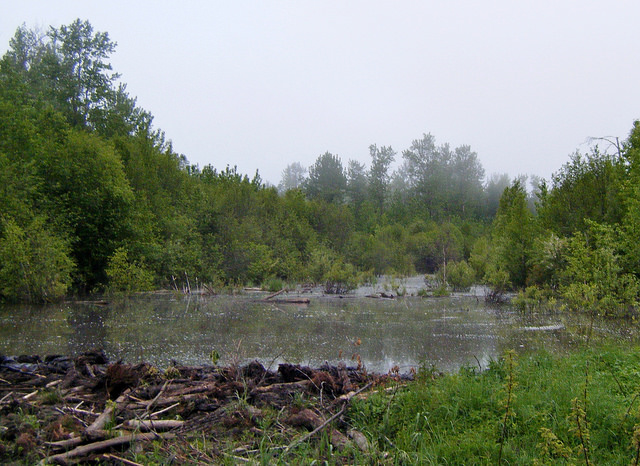Does a flood mitigation “dry dam” require an environmental assessment? by Adam Driedzic
Today’s post is courtesy of Adam Driedzic, Staff Counsel at the Environmental Law Centre, and first appeared on the ELC blog. If you would like to read more about environmental legislation, public policy or regulation, visit the Environmental Law Centre website or blog.
Nose Creek Watershed Tour-October 3, 2014
On October 3rd the WaterPortal participated in a tour of the Nose Creek Watershed hosted by Calgary River Valleys. We reported live from the event using Twitter. For our readers who don’t use Twitter, we have put together a Storify document with all the tweets from the tour. If you have any comments or feedback send us an email.
Water restrictions in Turner Valley, Black Diamond: Summer Stories Worth Revisiting
Welcome to the last instalment in our ‘Summer Stories Worth Revisiting’ series. This summer there were a number of water stories that took an interesting turn and this past week we’ve been reposting five stories that are worth a second look. Our last post looks at water restrictions that impacted Okotoks, Turner Valley and Black Diamond in 2014.
Cochrane Lake: Summer Stories Worth Revisiting
Issues with Cochrane Lake have been ongoing over the past three years but there were a number of significant developments this summer.
Proposed Maligne Lake Development: Summer Stories Worth Revisiting
Welcome to the third instalment in our ‘Summer Stories Worth Revisiting’ series! Today we look at Maligne Lake.
Maligne Lake is the largest natural lake in the Canadian Rockies and the picturesque setting makes the area a popular tourist destination. In April news broke that Maligne Tours, a local tourist company, proposed building a 66-room hotel. Currently, Maligne Lake is a 9-5 attraction.
Ghost Lake Reservoir: Summer Stories Worth Revisiting
In part two of our “Summer Stories Worth Revisiting” series, we look at the summer 2014 Ghost Reservoir flood mitigation pilot project.
Invasive Mussels: Summer Stories Worth Revisiting
Although it is officially fall, we at the WaterPortal are still dwelling on summer. Beyond the heat and sunshine there were some ongoing water stories that took an interesting turn this summer. This week we’ll be posting five stories we felt were worth revisiting.
Combining Public Art, Infrastructure and Water – A Precious Natural Resource by Corrina Baxter
Today’s blog post first appeared in the Bow River Basin Council’s publication ‘Preserving Our Lifeline‘. You can read past newsletters and editions of ‘Preserving Our Lifeline’ here.
Five hundred illuminated spheres float down the Bow River, twinkling brighter than the stars above. Festival-going families drink from funky fountains, their refreshing water drawn from fire hydrants. And teeming micro-organisms are studied in City water treatment labs, soon to be part of unique blown glass sculptures.
2014 Summer Wrap Up: Top 10 News Stories
As the summer winds down, we thought we would do a quick recap of our top news stories for those who (wisely) spent more time by the lake than by the computer. Using Bitly stats we organized the articles by the number of clicks and included the articles published between June 1st and August 29th that received the most clicks from our readers.
|
|
Beavers— An Ally or an Inconvenient Species? by Lorne Fitch
While beavers have sometimes been considered a nuisance, recent studies suggest beavers can play a role in flood prevention and can help even protect waterways. Today’s blog post was written by Lorne Fitch, Provincial Riparian Specialist with Cows and Fish: Alberta Riparian Habitat Management Society. If you would like to learn more about beavers and management of riparian areas visit the Cows & Fish website.
 |
| Photo: “elk island june 17 2014” by wapiti8 is licenced under CC BY 2.0. |
The beaver is quite a package: it swims like a fish, cuts like a chain saw, moves materials like a front end loader, is the first water engineer and the first logger, and transforms landscapes at a scale that rivals humans. Some might consider them an inconvenient species.
As our national symbol the beaver is equally loved, hated and universally misunderstood. They can come with horns or halos. When they flood roads and property, cut favorite trees or inconvenience us in other ways they can seem the evil incarnate. To the myriad of plant, insect, fish and wildlife species beavers create habitat for and, to those that appreciate biodiversity, beavers are divinely inspired. In that balance beavers are seriously underrated as a species that can help us weather the storm of climate change.
The essence of climate change is greater variability in our weather. For many landscapes the trend is towards warmer and drier conditions. It may also mean more violent storms that dump massive amounts of rain in a short time period. It’s a conundrum of generally less precipitation overall, but delivery faster than the landscape can absorb. In a perverse way it means increased drought and flood conditions, often within the same year.

